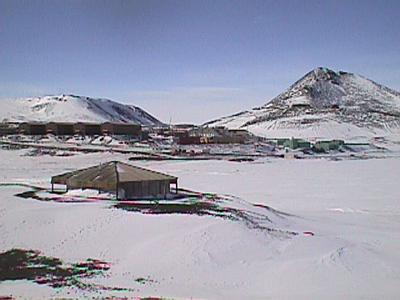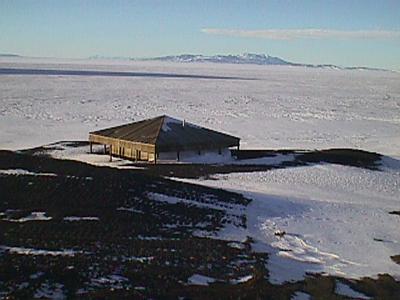24 November, 1999
The final historical hut of the "Heroic Age" of Antarctic exploration I want
to show you is the one constructed by Robert Scott's expedition in 1902. I
hope you have realized that I have not shown you these huts in chronological
order, but in order by their decreasing distance from McMurdo Station.
Scott's Discovery Hut is located just across the harbor from Mactown. It is
a short walk around the harbor basin to Hut Point. Because of it's location
so near to McMurdo, it is the most visited and probably the most scrounged
by visitors of any of the historic huts.
Scott led the National Antarctic Expedition aboard the ship Discovery
leaving England in August 1901. They arrived at McMurdo Sound and erected
the prefabricated hut in February of 1902. The site, on a rather windy,
exposed point, was probably selected because of its proximity to a
deep-water harbor in McMurdo Sound. The hut was of a design used in the
outback of Australia and not parcticularly suited for the Antarctic. In fact,
Scott's party actually stayed aboard the Discovery, frozen in the sea ice,
and used the hut only for storage, scientific work and social gatherings
including the "The Royal Terror Theatre" (Hey, it was a long winter!) During
the Discovery Expedition Scott made his first attempt at the South Pole.
Accompanied by Ernest Shackleton and Edward Wilson, he got as far south as
82 degrees latitude before having to turn back. Upon returning to Hut Point,
most of the party spent another winter (Shackleton, among others returned.)
before returning to England in the spring of 1904.
The Discovery Hut was used several times by subsequent expeditions including
Shackleton's Nimrod Expedition and the Imperial Trans-Antarctic Expedition,
which lead to Shackleton's saga aboard the Endurance.
As you approach the hut, it looks quite handsome with its symmetrical roof
silhouetted against the Transantarctic Mountains in the distance. Snow has
blown under the over hangs. There is a deteriorated seal carcass outside the
hut. Hut Point is a pleasant destination to walk to and sit, although it is
often quite windy. Weddell seals are often seen resting on the ice near the
crack that extends out from Hut Point. Discovery Hut, like the other
historic huts I have described is maintained by the Antarctic Heritage
Trust. For more information about the AHT and the preservation work being
done in Antarctica see this website:
http://www.heritage-antarctica.org/ahtnz/sites/index.htm.
I want to talk about a couple of the projects that we have going on right
now. First, the evaporation experiment. I have been running mine for about
140 hours. Here are some preliminary data. I have listed the average depth
of the water in the pan and the time from the start of the experiment.
Time (hours) Depth (mm)
0 35
26 35
45 33
62 32
86 31
110 30
134 28
Try graphing this information. See if you can predict when the water in the
pan will be all evaporated. How do the results compare to yours so far?
Also, I have not received very many names for my penguin. I don't want to
leave the ice with an unnamed penguin. Put on your thinking caps and send me
your name suggestions. I will take ideas until the end of next week.
I will write a journal on 11/25 (Thanksgiving) but will not the next two
days (11/26 & 11/27). On Sunday, 11/28, I will tell you all about
Thanksgiving in Antarctica.

Discovery Hut on Hut Point with McMurdo Station and Observation Hill in the background.

Scott's Discovery Hut. This building was designed for the Australian outback.

Snow against the wall of the hut. Note the large overhangs.

A mummified seal carcass left outside the hut.

Hut Point: A beautiful spot on the Ross Sea with the Transantarctic Mountains in the background.
Contact the TEA in the field at
.
If you cannot connect through your browser, copy the
TEA's e-mail address in the "To:" line of
your favorite e-mail package.
|
